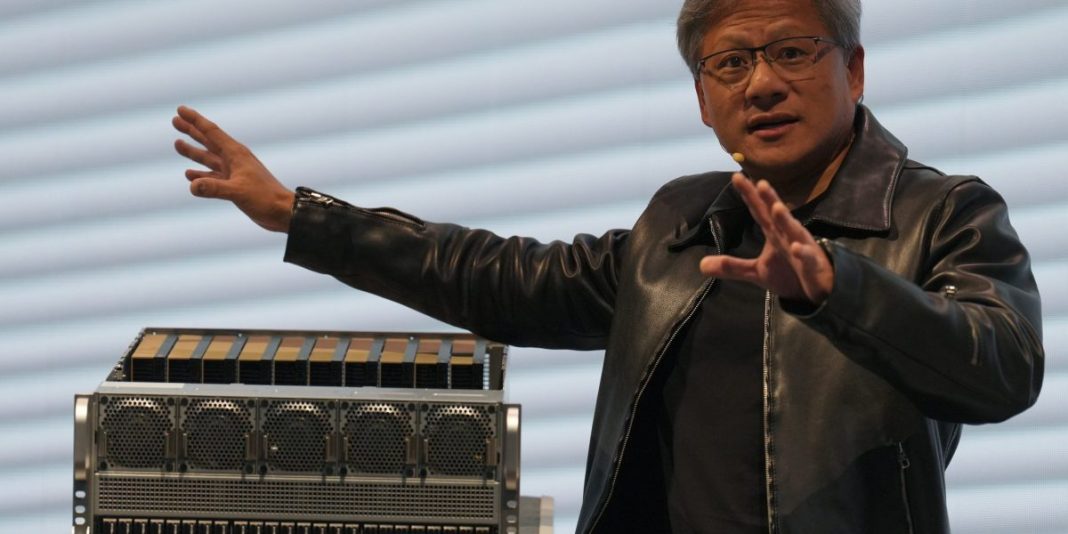After the market’s close, Nvidia’s 10-for-1 stock split, which was announced in May during the company’s most recent earnings call, went into effect. But it will do little to change the company’s $3 trillion valuation or its underlying fundamentals, which so far, have investors licking their chops.
“You and I know that a stock split is just cosmetic, at least it is for existing shareholders,” says Paul Meeks, a veteran tech investor and business school professor at military college The Citadel. “With their investor relations routine, Nvidia is well aware they have to keep on throwing a few bones out there” to investors.
Few other companies have embodied the new corporate hierarchy pecking order ushered in by the proliferation of AI quite like Nvidia has. The company’s stock rose 3,174% over the last five years and 218% in just the last year. During its epic run, Nvidia’s market cap soared past the likes of Amazon and Alphabet. Before the 10-for-1 split, the stock was at a stratospheric $1,209.
That price was likely too high for most investors, certainly the retail investors the split was meant to attract, according to Humayun Sheikh, CEO of startup Fetch.ai, which provides developer tools specifically for AI. “The stock split enhances Nvidia’s appeal by making shares more affordable, thus broadening its investor base,” he said.
Sheikh too sees the move, at least partially, about investors’ perceptions, saying it was likely “influenced by optics” and could accelerate market cap gains.
Nvidia’s position as the firm that has cornered the market on providing AI developers all the chips and computing power they need isn’t changing because of the stock split. In the first quarter, Nvidia’s sales rose 262% annually to $26 billion, outperforming Wall Street’s already lofty expectations.
Nvidia’s stock rally also serves as a hint at what the AI boom could still have in store.
“Nvidia’s change in price over the last year is telling us something about the market, namely, that perhaps AI is the new general purpose technology, like the internet or electricity, which will have massive productivity implications across the economy, and therefore AI companies will benefit greatly,” said NYU business school professor Vasant Dhar.
What could potentially go wrong with Nvidia’s stock split?
Still, investors are considering a few scenarios in which things might go south for them after the stock split, even as they admit the odds are slim.
For Meeks, the only thing that could halt Nvidia’s march to the top is an economy-wide slowdown, which he considers unlikely because he expects the U.S. will avoid a recession and that the Federal Reserve will lower interest rates in early 2025. In fact, he’s already thinking about Nvidia’s performance should the economy improve.
“It’d be hard for these stocks to lose their gains if all of a sudden we go from wind in our face with high rates to wind at our back with low rates,” Meeks said.
Meanwhile, Sheikh said the retail investors the split was meant to attract are another possible, but unlikely, concern. Individually, retail investors may hold small amounts of Nvidia stock. But collectively, they can make up a significant portion of shares. So any shocks to the system or unexpected changes in their views on the company can still have a notable effect. One need look no further than GameStop to understand the outsize influence retail investors can have on the market.
Reducing the stock to one-tenth of its price could be a double edged sword. “This approach might appeal to Robinhood-type investors or meme stock enthusiasts,” Sheikh added. “However, if the narrative turns against Nvidia and speculative traders start selling off, it could impact the price negatively.”
But even if that unwelcome scenario were to happen it wouldn’t change all the market trends propping up the chipmaker.
“Nvidia already had a huge run up in price, so any tailwind from a stock split will be miniscule in comparison to the ‘fundamental’ reasons for its performance,” Dhar said.


